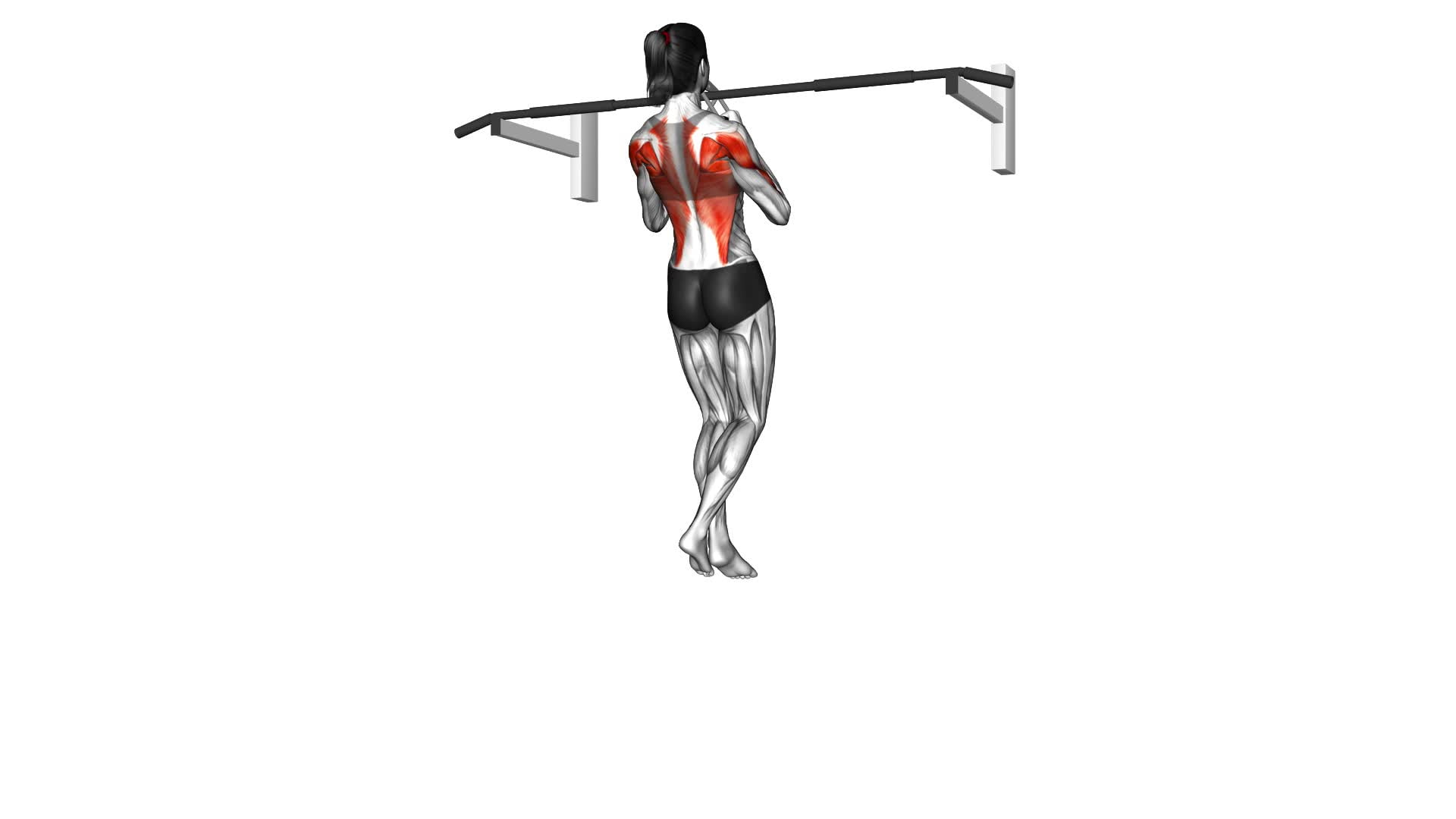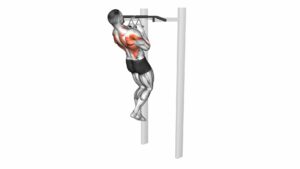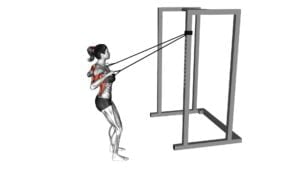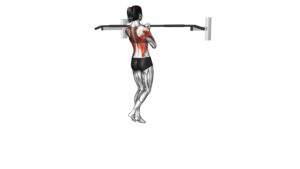Chin-Ups (Narrow Parallel Grip) (Female) – Video Exercise Guide & Tips

Looking to strengthen your upper body and improve your overall fitness? Check out this video exercise guide for narrow parallel grip chin-ups, specifically designed for females.
Watch This Exercise Video
In just a few minutes, you'll learn the proper form, the benefits of incorporating chin-ups into your workout routine, and helpful tips for increasing your strength and endurance.
Whether you're a beginner or looking to progress, this guide has got you covered. Get ready to conquer those chin-ups and achieve your fitness goals!
Key Takeaways
- Maintain proper form throughout the exercise
- Engage the core and avoid body swinging
- Fully extend the arms at the bottom of the movement
- Keep elbows close to the body
Proper Form for Narrow Parallel Grip Chin-Ups
To perform narrow parallel grip chin-ups correctly, you should make sure to maintain proper form throughout the exercise. One common mistake isn't engaging the core and allowing the body to swing. To avoid this, focus on keeping your body straight and stable.
Another mistake isn't fully extending the arms at the bottom of the movement. Be sure to fully straighten your arms before pulling yourself back up.
Proper technique also involves keeping your elbows close to your body and pulling yourself up until your chin is above the bar. Avoid using momentum to complete the movement and instead rely on your upper body strength.
Remember to breathe throughout the exercise, exhaling as you pull yourself up and inhaling as you lower yourself down.
Benefits of Incorporating Chin-Ups Into Your Workout Routine
Incorporating chin-ups into your workout routine can provide numerous benefits for your overall fitness and strength. Here are three reasons why you should consider adding chin-ups to your exercise regimen:
- Muscle activation during chin-ups: Chin-ups primarily target the muscles in your upper body, including your back, arms, and shoulders. By performing this exercise, you activate and strengthen these muscle groups, helping you build a balanced and toned physique.
- Improved upper body strength: Chin-ups are a challenging exercise that requires you to lift your own body weight. As you gradually increase your strength and ability to perform more reps, you'll notice significant improvements in your upper body strength. This can translate into better performance in other activities, such as lifting heavy objects or participating in sports.
- Enhanced posture: Regularly incorporating chin-ups into your workout routine can help improve your posture. This exercise targets the muscles in your upper back and shoulders, which are often weakened due to sedentary lifestyles and poor posture habits. By strengthening these muscles, chin-ups can help correct imbalances and promote better posture.
Tips for Increasing Your Chin-Up Strength and Endurance
To increase your chin-up strength and endurance, focus on incorporating proper technique and gradually increasing the intensity of your workouts.
Start by ensuring that you have a solid foundation in the basic chin-up exercise. This means using a narrow parallel grip, keeping your body straight, and engaging your core muscles throughout the movement.
As you progress, you can begin to increase the number of chin-up reps you do in each set. Aim to add one or two reps to your total each week, gradually building up your strength and endurance.
Additionally, incorporating advanced chin-up variations can help to challenge your muscles in new ways and prevent plateaus. Some examples of advanced variations include wide grip chin-ups, weighted chin-ups, and one-arm chin-ups. These variations require additional strength and stability, helping to further develop your upper body muscles.
By gradually increasing the intensity of your workouts and incorporating advanced chin-up variations, you can continue to challenge yourself and make progress.
Once you have mastered the tips for increasing your chin-up strength and endurance, you can move on to modifications and progressions for beginners.
Modifications and Progressions for Beginners
If you're a beginner, you can gradually progress your chin-up strength and endurance by incorporating modifications and progressions into your workouts. Here are three ways to modify and progress your chin-ups:
- Assisted Chin-Ups: If you find it difficult to perform a full chin-up, you can use an assisted chin-up machine or resistance bands to provide assistance. By reducing the amount of weight you have to lift, you can focus on proper form and gradually build strength.
- Negatives: Another modification for beginners is to focus on the eccentric phase of the chin-up, which is the lowering portion. Jump or use a step to get into the top position and then slowly lower yourself down. This helps build strength in the muscles used during the chin-up.
- Chin-Up Holds: To progress your chin-up strength, you can incorporate holds into your workouts. Start by jumping or using a step to get into the top position of a chin-up and hold for as long as you can. Over time, aim to increase the duration of the hold.
By incorporating these modifications and progressions into your workouts, you can gradually improve your chin-up strength and endurance. However, it's important to note that proper form and technique should always be prioritized to prevent injury and maximize results.
Now, let's move on to the next section and discuss common mistakes to avoid when performing chin-ups.
Common Mistakes to Avoid When Performing Chin-Ups
To avoid common mistakes when performing chin-ups, make sure you're using proper form and technique.
- One of the most common mistakes is using a wide grip instead of a narrow parallel grip. Using a wide grip can put excessive strain on your shoulders and make it harder to engage your back muscles effectively.
- Another mistake to avoid is using momentum to swing your body up and down. This takes away from the targeted muscle engagement and can lead to injury. Instead, focus on using controlled movements and engaging your core to maintain stability.
- Additionally, avoid shrugging your shoulders up towards your ears during the exercise. This can cause unnecessary tension in your neck and shoulders and reduce the effectiveness of the exercise.
- Finally, make sure to fully extend your arms at the bottom of each rep and reach your chin over the bar at the top. These techniques will help you maximize the benefits of chin-ups and minimize the risk of injury.
Frequently Asked Questions
What Are Some Alternative Exercises for Chin-Ups That Target the Same Muscle Groups?
If you're looking for different variations of pull ups to target the same muscle groups as chin-ups, there are a few options to consider. Wide grip pull ups, commando pull ups, and close grip pull ups are all effective alternatives.
Additionally, resistance band exercises can provide a great alternative to chin-ups. By attaching a resistance band to a pull-up bar, you can mimic the movement and still work those same muscle groups.
How Many Sets and Reps Should I Do When Incorporating Chin-Ups Into My Workout Routine?
To determine the optimal rep range for incorporating chin-ups into your workout routine, consider your fitness level.
Beginners should start with 3-4 sets of 6-8 reps, gradually increasing as strength improves.
Advanced individuals can aim for 3-5 sets of 8-12 reps.
To progress, try adding weight with a weight belt or using resistance bands to assist with the movement.
Focus on gradually increasing both strength and endurance in your chin-up exercises.
Can Chin-Ups Help Improve Posture and Upper Body Strength?
Chin-ups can be a great exercise for improving posture and upper body strength. By engaging your back, shoulder, and arm muscles, chin-ups help to strengthen the muscles that support good posture.
Additionally, the pulling motion of chin-ups targets the muscles in your upper body, including your biceps, triceps, and deltoids, helping to build overall upper body strength.
Incorporating chin-ups into your workout routine can be an effective way to enhance both your posture and upper body strength.
Are There Any Specific Stretches or Warm-Up Exercises I Should Do Before Attempting Chin-Ups?
Before attempting chin-ups, it's important to warm up properly. Start with dynamic stretches like arm circles and shoulder rolls to loosen up the upper body.
Incorporate exercises that target the muscles used in chin-ups, such as assisted pull-ups or lat pulldowns. These specific warm-up exercises will help activate the muscles, increase blood flow, and reduce the risk of injury.
Can Women Perform Narrow Parallel Grip Chin-Ups, or Are They More Suitable for Men?
Yes, women can perform narrow parallel grip chin-ups. They aren't just suitable for men. Women's upper body strength can vary, but with practice and consistency, they can build the necessary strength to perform this exercise.
Chin-ups offer numerous benefits for women, such as strengthening the back, arms, and core muscles. Incorporating chin-ups into your workout routine can help improve overall upper body strength and contribute to a more toned physique.
Conclusion
Incorporating narrow parallel grip chin-ups into your workout routine can be a great way to strengthen your upper body and improve your overall fitness. By focusing on proper form and gradually increasing your strength and endurance, you can make progress and achieve your fitness goals.
Remember to start with modifications and progressions if you're a beginner, and avoid common mistakes to ensure a safe and effective chin-up workout.
Keep pushing yourself and enjoy the benefits of this challenging exercise.

Author
Years ago, the spark of my life’s passion ignited in my mind the moment I stepped into the local gym for the first time. The inaugural bead of perspiration, the initial endeavor, the very first surge of endorphins, and a sense of pride that washed over me post-workout marked the beginning of my deep-seated interest in strength sports, fitness, and sports nutrition. This very curiosity blossomed rapidly into a profound fascination, propelling me to earn a Master’s degree in Physical Education from the Academy of Physical Education in Krakow, followed by a Sports Manager diploma from the Jagiellonian University. My journey of growth led me to gain more specialized qualifications, such as being a certified personal trainer with a focus on sports dietetics, a lifeguard, and an instructor for wellness and corrective gymnastics. Theoretical knowledge paired seamlessly with practical experience, reinforcing my belief that the transformation of individuals under my guidance was also a reflection of my personal growth. This belief holds true even today. Each day, I strive to push the boundaries and explore new realms. These realms gently elevate me to greater heights. The unique combination of passion for my field and the continuous quest for growth fuels my drive to break new ground.







